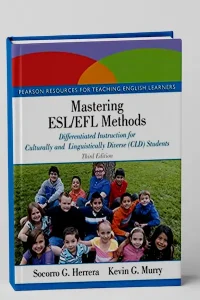As the title implies, Mastering ESL/EFL Methods is about methods. Yet it is also about differentiating instruction and professional practice to accommodate the distinct learning and transition needs of CLD students in both English as a second language and English as a foreign language settings.
About Mastering ESL/EFL Methods
This guide gives current and future educators practical help for rediscovering the value, potential, richness, and adventure of a diverse classroom–while developing the capacity to professionally address the differential learning and transition needs of culturally and linguistically diverse (CLD) students.
Ideal for pre-and in-service teachers, district and building administrators, school specialists, and paraprofessionals, it presents the latest tools, procedures, strategies, and ideas for ensuring effective teaching and learning for students of any native language.
Included are new ways to reach and maximize relationships with parents, caregivers, and extended family members by partnering with them in appropriate pedagogical practices.
The new Third Edition includes illustrated concepts; global connections; tips for practice in the EFL classroom; a revised framework for the conceptual definitions of approach method, strategy, and technique; an expanded Glossary; interactive video links; a revised discussion of dual language programs; and an overview of program model effectiveness.
New Features
- Illustrated Concepts for each chapter provide educators examples of practical ways to implement the theoretical concepts found in the book.
- Global Connections feature English language teaching from a global perspective by connecting what is learned to EFL settings.
- Tips for Practice for EFL classrooms include advice for teachers to implement strategies and techniques for EFL/global settings.
- Video Links offer teachers a multimedia approach to see our theoretical concepts in actions via short video clips, available only through the Pearson eText (other eText formats do not support video).
- A revised framework for conceptual definitions of approach, method, strategy, and technique in Chapter 6 allows educators to be able to articulate how their instruction is grounded in current theory and research.
- An expanded glossary includes accessible definitions of key terms to support readers’ understanding of context.
- New and updated figures and tables assist teachers to visualize the theories and scholarship discussed within each chapter.
- New and updated sources and resources and an updated reference list familiarize readers with the latest being written and talked about in the education of CLD students.


